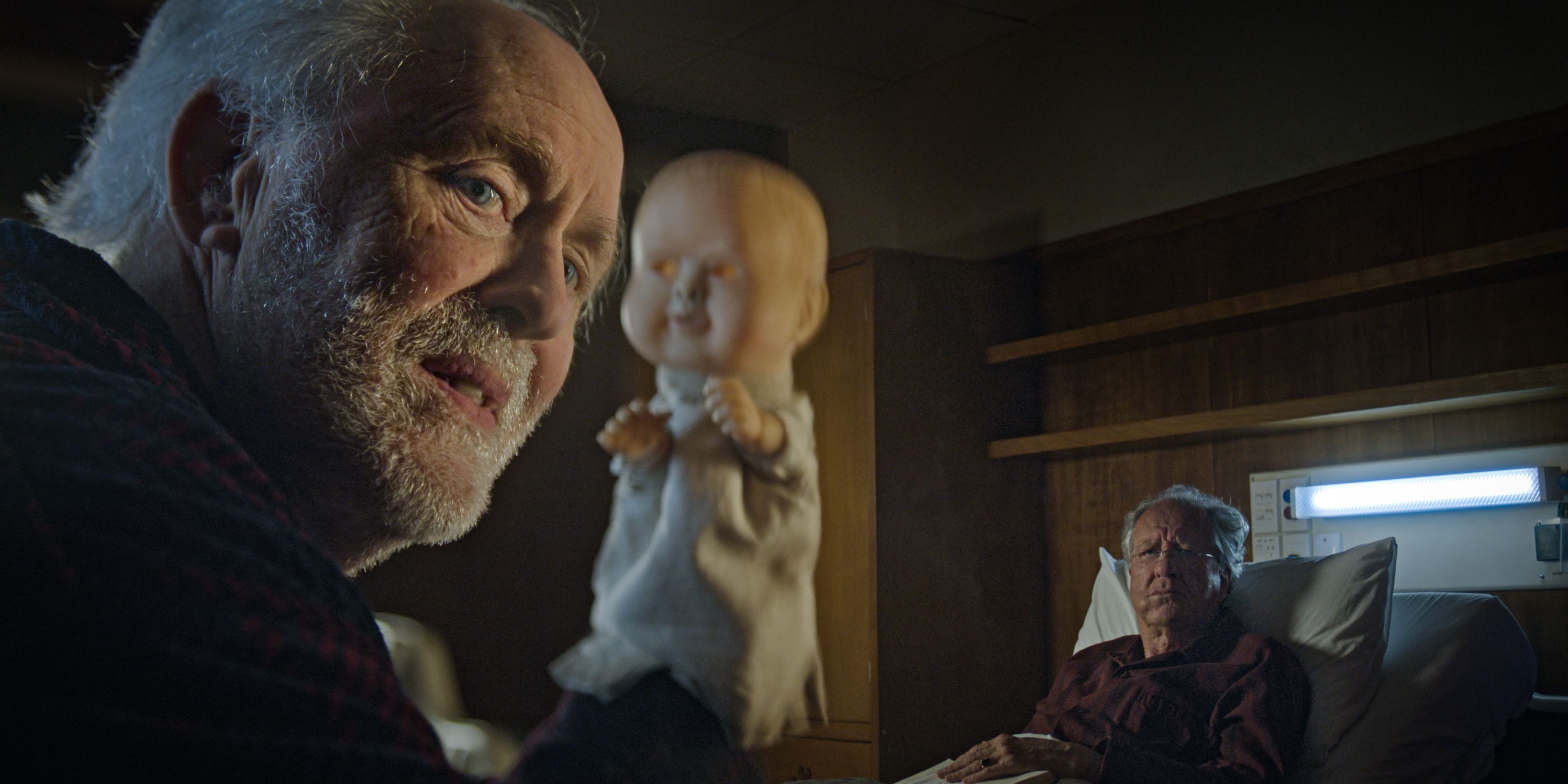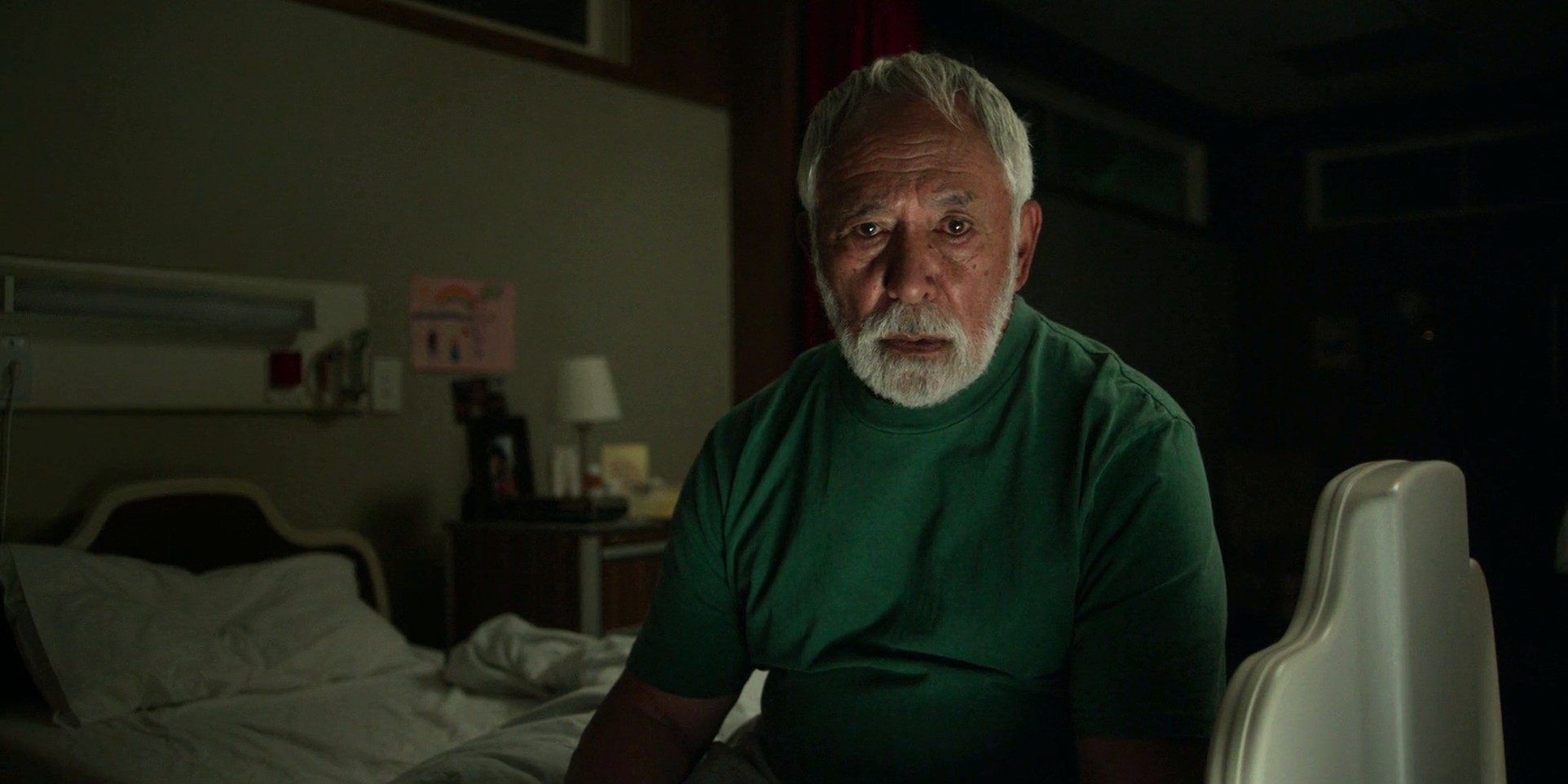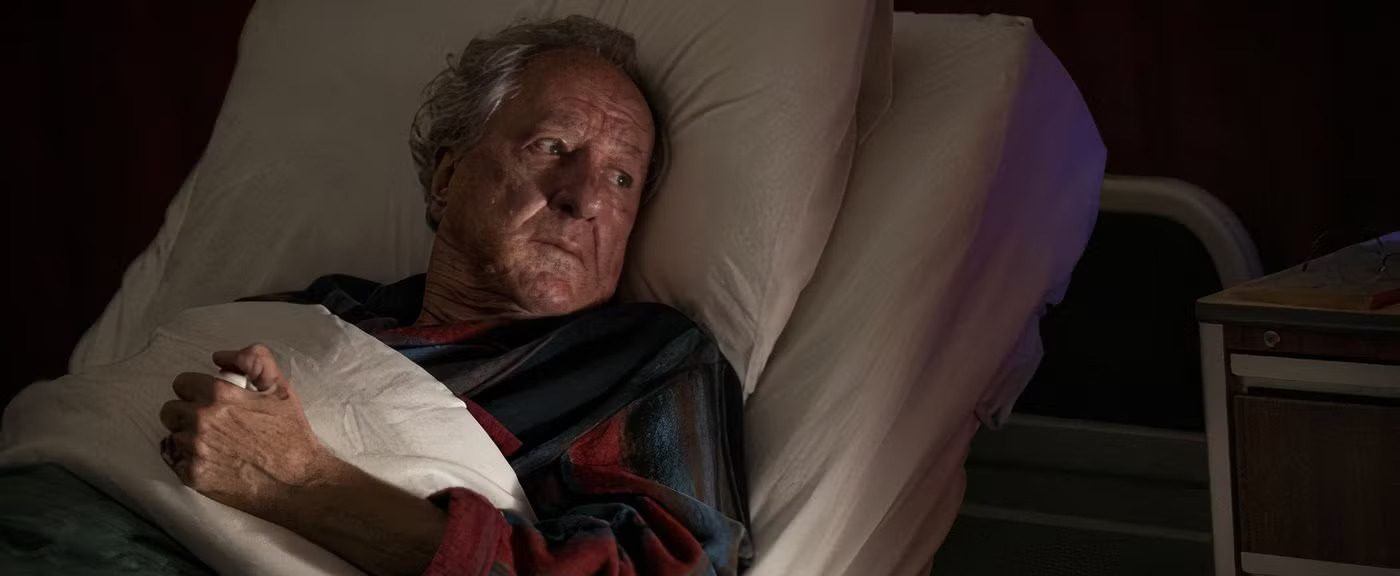Directed by James Ashcroft, Shudder’s psychological horror film ‘The Rule of Jenny Pen’ concludes with a compelling and emotionally charged climax, delivering the long-awaited catharsis viewers crave. After enduring relentless torment at the hands of Dave Crealy, Stefan Mortensen finally seizes control of his fate, joining forces with his steadfast ally, Tony Garfield, in a showdown. Together, they dismantle the oppressive grip that has plagued Royal Pine Mews, ushering in a long-overdue sense of hope that conquers the darkness. Yet, despite its deeply satisfying conclusion, the movie leaves audiences with lingering questions that challenge their understanding of the story’s intricate layers! SPOILERS AHEAD.
The Rule of Jenny Pen Plot Synopsis
‘The Rule of Jenny Pen’ follows the harrowing life journey of Stefan Mortensen, a once-formidable judge whose life takes a tragic turn after a debilitating stroke compels him to use a wheelchair. Forced to reside in the isolated Royal Pine Mews care home, Stefan grapples with his new reality, surrounded by the echoes of his past authority. However, his existence soon becomes a nightmare as he encounters Dave Crealy, a sadistic psychopath who revels in terrorizing the residents. Armed with his eerie puppet doll, Jenny Pen, as a sinister emblem of his cruelty, Dave’s reign of torment casts a long shadow over the care home.

As Stefan endures relentless psychological and physical abuse at the hands of Dave, his grip on reality begins to waver. The line between hallucination and truth blurs, leaving him questioning his own sanity. Despite his attempts to report Dave’s heinous acts to the staff, they dismiss his claims, blinded by the latter’s charming façade. This dismissal only deepens Stefan’s isolation and despair. The situation escalates when Joyce, another resident who suffers under the antagonist’s torment, tragically dies under mysterious circumstances, intensifying the atmosphere of fear and helplessness. In a desperate bid for freedom from this tormentor, Stefan devises a plan to incapacitate Dave by exhausting his inhalers.
However, this attempt ultimately fails, leaving Stefan more vulnerable than ever before. It is only when he allies himself with his fellow victim, Tony Garfield, that hope begins to flicker anew. Together, they muster the courage to confront their oppressor in a gripping showdown that culminates in them overpowering and eliminating Dave once and for all.
The Rule of Jenny Pen Ending: Why Does Dave Torture His Fellow Residents?
Dave Crealy hasn’t always been a resident of Royal Pine Mews; he was once a staff member, someone who had authority in a different way. But instead of caring for the people there, he found something far more sinister in the environment: a place where he could exert complete dominance over those too weak to fight back. When he eventually became a resident himself, he didn’t lose that hunger for control. If anything, his cruelty only intensified because now, he became untouchable.

What makes Dave’s sadism even more twisted is his choice of victim. Stefan Mortensen, once a powerful judge, represents everything he has always resented. Stefan was a man of authority, a person who held the kind of power Dave could never truly grasp. But after his stroke, that power was stripped away, leaving him vulnerable, stuck in a wheelchair, and completely at Dave’s mercy. The antagonist finds a perverse joy in breaking someone like the former judge, a figure who once commanded respect, and reducing him to a frightened, helpless shell. For Dave, Stefan becomes a prize more than just another victim.
This explains why Dave’s torture is not just about physical pain but also psychological erosion. He blurs Stefan’s sense of reality, pushing him to the brink of madness and making him question what’s real and what isn’t. It’s not enough for Dave to make Stefan suffer; he wants to dismantle everything the former judge used to be. The puppet, Jenny Pen, becomes an extension of this torment: a symbol of control, a reminder that no matter what Stefan once was, he is now just another plaything in Dave’s game. Dave’s cruelty stems from a deep-seated need for power, but it is not the kind of power that comes with respect or authority; it is the power of breaking people down, of seeing fear in their eyes and knowing that he is the cause of it.
Dave is not driven by revenge, nor does he have some tragic backstory that explains his actions. He is simply someone who enjoys domination, someone who sees weakness as an invitation rather than something to empathize with. His past as a staff member only adds another layer to his monstrosity. He wasn’t just another patient who snapped; he was someone who had always wielded control in the home, and when he lost his official authority, he carved out a new way to maintain it. He didn’t need permission, rules, or structure anymore. Now, he could do whatever he wanted, and no one was there to stop him. That’s what makes him terrifying. He is not just a random psychopath; he is someone who has thrived in an environment meant to be a place of safety, twisting it into his personal kingdom of suffering.
Is Jenny Pen Supernatural? Why is Dave Attached to It? Is it Destroyed?
Dave Crealy’s Jenny Pen is pivotal to the antagonist’s storyline in ‘The Rule of Jenny Pen.’ The doll itself is not supernatural but exudes an unsettling, almost otherworldly presence. Dave refers to her as an integral part of his personality—a ruler to whom everyone must bow. Throughout the film, Jenny Pen appears to change expressions, grow in size, or even move independently. However, these moments are likely the result of Stefan Mortensen’s deteriorating mental state and his perception of the psychological torment inflicted by Dave.

Dave’s attachment to Jenny Pen symbolizes unparalleled power in an environment where he would otherwise be powerless. As a frail, elderly man in a nursing home, his physical limitations are starkly evident. However, his power comes not from traditional strength but through the fear he instills using Jenny Pen. The puppet becomes the focal point of his cruelty—a weapon to dominate and terrorize the residents and staff alike. While the doll itself lacks any supernatural qualities, Dave’s belief in its significance and the residents’ reactions transform it into a symbol of dread. He uses Jenny Pen as an extension of his twisted psyche, forcing others to submit to her “rule” while he hides behind her grotesque visage.
Jenny Pen’s role as a tool for psychological manipulation is particularly evident in her interactions with Stefan. A former judge recovering from a debilitating stroke, the protagonist struggles with his loss of independence and dignity. His refusal to acknowledge Jenny Pen’s authority makes him a prime target for Dave’s cruelty. Dave delights in breaking Stefan’s spirit, using Jenny Pen as a means to assert dominance over someone who once held societal power. The doll’s eerie presence and apparent autonomy—seen through Stefan’s increasingly paranoid perspective—illustrate the psychological toll of Dave’s relentless bullying.
In the film’s climactic moments, Stefan destroys Jenny Pen by throwing her into a fire. This act showcases the end of her reign over the care facility but holds little significance beyond the protagonist’s personal catharsis. The doll has never possessed any real power; it is merely a vessel for Dave’s cruelty and manipulation. Destroying it does not erase the trauma inflicted on Stefan or the other residents. However, for the former judge, burning Jenny Pen represents an attempt to reclaim agency and purge himself of the fear she embodied.
Why Does Tony Sing? What Does the Song Mean?
Tony Garfield sings the Māori haka “Ka Mate” towards the end of ‘The Rule of Jenny Pen,’ marking one of the film’s most powerful and transformative moments. Throughout the movie, Tony has endured relentless psychological and physical torment at the hands of Dave. However, his decision to sing “Ka Mate” is a bold act of defiance and a reclamation of his dignity after years of suffering. The haka “Ka Mate” is a traditional Māori war dance that embodies themes of resilience, courage, and triumph over adversity.

The haka is famously performed to celebrate victory or as a rallying cry to instill strength and solidarity among participants. The words of “Ka Mate,” written by Māori chief Te Rauparaha in the early 19th century, convey a story of survival and overcoming fear. By choosing to sing this song, Tony channels its powerful symbolism, transforming his pain and frustration into an act of rebellion against Dave’s oppressive behavior. Tony’s performance comes after he has reached his breaking point.
Throughout the film, Dave uses Jenny Pen as an extension of his cruelty, humiliating Tony and others in ways that strip them of their autonomy and humanity. The latter has been portrayed as a gentle yet vulnerable man who often tries to avoid conflict. However, he decides he has had enough by the film’s climax. Singing “Ka Mate” becomes his way of standing up to Dave—an act that symbolizes his refusal to be broken by years of torment. The haka itself is deeply symbolic within this context. Its rhythmic chanting and powerful movements evoke strength and unity, contrasting sharply with the atmosphere of fear that Dave has cultivated in the nursing home. As Tony sings “Ka Mate,” he disrupts the power dynamic that has allowed Dave to dominate for so long.
Stefan and Tony Kill Dave to End His Torture
By the end of ‘The Rule of Jenny Pen,’ Stefan Mortensen and Tony Garfield take matters into their own hands and kill Dave Crealy to end his reign of terror in the care home. This drastic act is not born out of malice but as a desperate response to years of psychological and physical torment inflicted by the antagonist. The murder serves as the ultimate act of resistance against Dave’s cruelty and symbolizes the reclaiming of agency by two men who have been pushed to their limits. The decision to kill the tormentor comes after both Stefan and Tony realize that no one else will stop him.

The care home staff remain oblivious to Dave’s true nature as they are distracted by other responsibilities or fooled by his harmless façade. Meanwhile, the residents are too frightened or traumatized to stand up to him. Stefan and Tony are left with no choice but to take justice into their own hands. This decision reflects one of the film’s central themes: the importance of standing up to bullies, even when it requires extreme measures. The murder itself is both shocking and cathartic. Stefan and Tony lure Dave into the laundry room under the guise of another confrontation. There, they ambush him and suffocate him with blankets.
This scene is tense and visceral, showcasing the desperation driving their actions. For Stefan and Tony, this act is about reclaiming their humanity after being dehumanized for so long. By killing Dave, they end his reign of terror and free themselves and the other residents from his oppressive control. What makes this moment even more significant is how it changes Stefan’s character arc. At the start of the film, the former judge is portrayed as a cold, prideful man who avoids forming connections with others. However, through his bond with Tony and their shared struggle against Dave, he learns the value of solidarity and courage. Killing Dave becomes an act of liberation not only for himself but also for everyone in the care home.
What Will Happen to Stefan?
After throwing Jenny Pen into the fire, we see a brief yet powerful shot of Stefan in the care home. This moment marks a significant transformation in his character, starkly contrasting the rigid, frustrated man we see in the earlier portions of the film. Throughout the lion’s share of the narrative, Stefan wrestles with his circumstances, refusing to accept the grim reality of his condition. His life had once been full of control and order, and the stroke robs him of everything that has defined his existence. However, by the end, Stefan is no longer consumed by denial. Instead, he finally begins to accept the irreversible damage the stroke has inflicted upon him.

For the first time, we see Stefan actively engaging with the care home residents. This is a crucial shift in his journey. Previously, he has viewed them as reminders of his worst fears—helplessness, dependence, and a loss of dignity. But now, having confronted his trauma, he begins to see them as people rather than mere symbols of his own decline. He starts bonding with them, participating in activities, and even finding moments of joy in his new reality. On the surface, this seems like a hopeful ending—Stefan is no longer resisting his fate; he is embracing it in the best way he can.
Yet, beneath this optimistic veneer, deeper, more unsettling layers remain. While Stefan has found a way to move forward physically and socially, his mind remains haunted by the horrors he has endured. The trauma inflicted by Dave is not something he can simply discard, even with Dave’s death. Memories of his tormentor’s sadistic manipulation, the helplessness he has experienced, and the sheer terror of those moments will forever be etched in his psyche. He may attempt to suppress these thoughts, but they will continue to surface, creeping into his quietest moments and shattering any sense of peace he tries to build.
However, despite the lingering trauma and physical limitations, there is a small yet significant silver lining. With Dave gone, the other care home residents can finally live without fear. Stefan’s presence, once distant and cold, has now become a source of connection. He may never fully escape his past, but in embracing his present, he has given the care home community a chance at a better future.
Read More: Best Lifetime Thriller Movies


